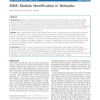Free Online Productivity Tools
i2Speak
i2Symbol
i2OCR
iTex2Img
iWeb2Print
iWeb2Shot
i2Type
iPdf2Split
iPdf2Merge
i2Bopomofo
i2Arabic
i2Style
i2Image
i2PDF
iLatex2Rtf
Sci2ools
130
Voted
BMCBI
2011
2011
MINE: Module Identification in NEtworks
Background: Graphical models of network associations are useful for both visualizing and integrating multiple types of association data. Identifying modules, or groups of functionally related gene products, is an important challenge in analyzing biological networks. However, existing tools to identify modules are insufficient when applied to dense networks of experimentally derived interaction data. To address this problem, we have developed an agglomerative clustering method that is able to identify highly modular sets of gene products within highly interconnected molecular interaction networks. Results: MINE outperforms MCODE, CFinder, NEMO, SPICi, and MCL in identifying non-exclusive, high modularity clusters when applied to the C. elegans protein-protein interaction network. The algorithm generally achieves superior geometric accuracy and modularity for annotated functional categories. In comparison with the most closely related algorithm, MCODE, the top clusters identified by MIN...
Related Content
| Added | 24 Aug 2011 |
| Updated | 24 Aug 2011 |
| Type | Journal |
| Year | 2011 |
| Where | BMCBI |
| Authors | Kahn Rhrissorrakrai, Kristin C. Gunsalus |
Comments (0)

